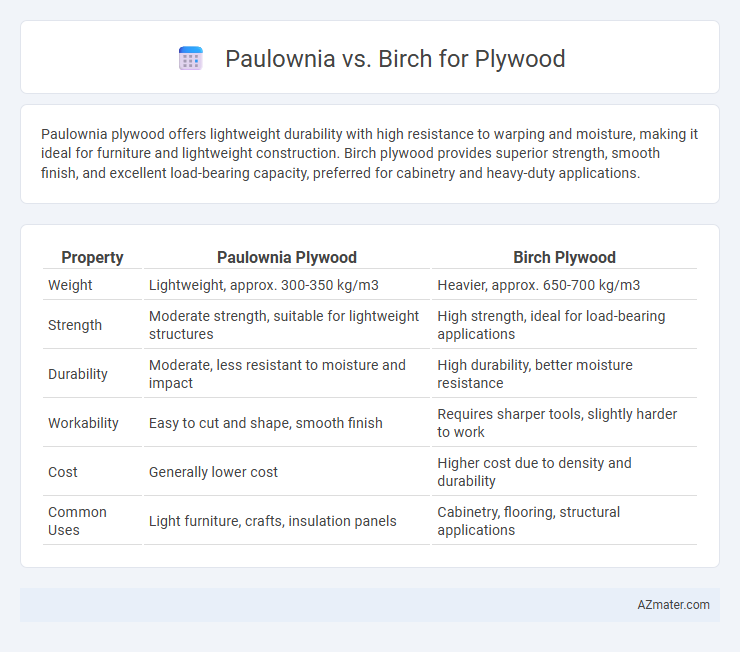Paulownia plywood offers lightweight durability with high resistance to warping and moisture, making it ideal for furniture and lightweight construction. Birch plywood provides superior strength, smooth finish, and excellent load-bearing capacity, preferred for cabinetry and heavy-duty applications.
Table of Comparison
| Property | Paulownia Plywood | Birch Plywood |
|---|---|---|
| Weight | Lightweight, approx. 300-350 kg/m3 | Heavier, approx. 650-700 kg/m3 |
| Strength | Moderate strength, suitable for lightweight structures | High strength, ideal for load-bearing applications |
| Durability | Moderate, less resistant to moisture and impact | High durability, better moisture resistance |
| Workability | Easy to cut and shape, smooth finish | Requires sharper tools, slightly harder to work |
| Cost | Generally lower cost | Higher cost due to density and durability |
| Common Uses | Light furniture, crafts, insulation panels | Cabinetry, flooring, structural applications |
Introduction: Paulownia vs Birch Plywood
Paulownia plywood offers a lightweight and strong alternative to traditional birch plywood, making it ideal for applications requiring easy handling and durability. Birch plywood is prized for its dense grain and superior resistance to impact, providing excellent structural strength and a smooth finish for furniture and cabinetry. Comparing Paulownia and birch plywood reveals significant differences in weight, strength, and workability, guiding material selection based on project requirements.
Wood Characteristics: Paulownia vs Birch
Paulownia plywood is lightweight and resistant to warping, making it ideal for applications requiring durability and ease of handling, whereas birch plywood offers superior hardness and strength, providing excellent structural stability and wear resistance. Paulownia's porous grain results in good insulation and moisture resistance compared to birch's tighter grain, which contributes to its high impact resistance and smooth finish suitability for furniture and cabinetry. The lower density of Paulownia aids in faster drying and reduces material weight, while birch plywood's dense, fine-grained texture enhances its bonding capacity and sanding quality.
Density and Weight Comparison
Paulownia plywood has a significantly lower density, typically around 280-350 kg/m3, compared to birch plywood, which averages 600-700 kg/m3, making paulownia nearly half the weight of birch. This difference in density results in paulownia plywood being much lighter, ideal for applications requiring ease of handling and reduced weight load. Birch plywood offers higher strength and durability due to its greater density, making it suitable for structural uses where weight is less critical.
Strength and Durability Factors
Paulownia plywood is known for its lightweight properties but generally offers lower strength and durability compared to birch plywood, which is valued for its exceptional hardness and resistance to wear. Birch plywood exhibits superior screw-holding capacity and impact resistance, making it ideal for applications requiring structural stability and long-lasting performance. While Paulownia's moisture resistance is moderate, birch plywood provides enhanced durability in humid conditions due to its denser grain structure and natural resistance to warping.
Workability and Machining
Paulownia plywood offers exceptional workability due to its lightweight and soft texture, making it easier to cut, shape, and plane compared to birch. Birch plywood, while denser and harder, provides a smoother surface finish and holds fasteners more securely, but requires sharper tools and more effort during machining. Both woods are suitable for different applications based on tooling capacity and desired durability, with Paulownia favored for intricate craftsmanship and birch for heavy-duty uses.
Environmental Impact and Sustainability
Paulownia plywood offers significant environmental benefits due to its rapid growth rate, requiring fewer resources and less land compared to slower-growing birch, which takes decades to mature and sequesters less carbon during cultivation. Birch plywood, while known for its durability and strength, relies on hardwood forests, contributing to deforestation concerns and slower regeneration rates, impacting biodiversity negatively. The lightweight nature of paulownia reduces transportation emissions, enhancing its sustainability profile compared to the heavier birch plywood that demands more energy for transport and processing.
Moisture Resistance and Stability
Paulownia plywood offers superior moisture resistance due to its low density and natural oils, making it less prone to water absorption compared to birch plywood. Birch plywood provides excellent stability and strength but tends to absorb more moisture, which can lead to warping or swelling in humid conditions. For applications demanding high durability in moist environments, paulownia plywood is often preferred, while birch plywood suits projects requiring robust structural integrity under controlled moisture levels.
Cost and Availability
Paulownia plywood is significantly cheaper due to the fast growth rate of Paulownia trees, which results in abundant supply and lower harvesting costs compared to Birch. Birch plywood, known for its strength and durability, is generally more expensive as Birch trees take longer to mature and are less widely available. While Paulownia offers cost-effective plywood with good lightweight properties, Birch remains preferred for applications requiring higher structural integrity despite the premium price.
Common Applications: Paulownia vs Birch Plywood
Paulownia plywood is widely used for lightweight applications such as aircraft interiors, model making, and furniture due to its low density and high stiffness. Birch plywood is favored in construction, cabinetry, and flooring for its strength, durability, and smooth finish. Both types excel in veneer quality, but birch offers superior load-bearing capacity, while paulownia provides ease of handling and resistance to warping.
Conclusion: Choosing the Right Plywood Material
Choosing between Paulownia and Birch plywood depends on your project's requirements for weight, strength, and cost. Paulownia plywood is lightweight and easy to work with, making it ideal for applications where minimal weight is crucial, while Birch plywood offers superior durability and a smooth finish suitable for furniture and cabinetry. Prioritize Birch plywood for high-strength demands, whereas Paulownia is better for lightweight structural uses.

Infographic: Paulownia vs Birch for Plywood
 azmater.com
azmater.com